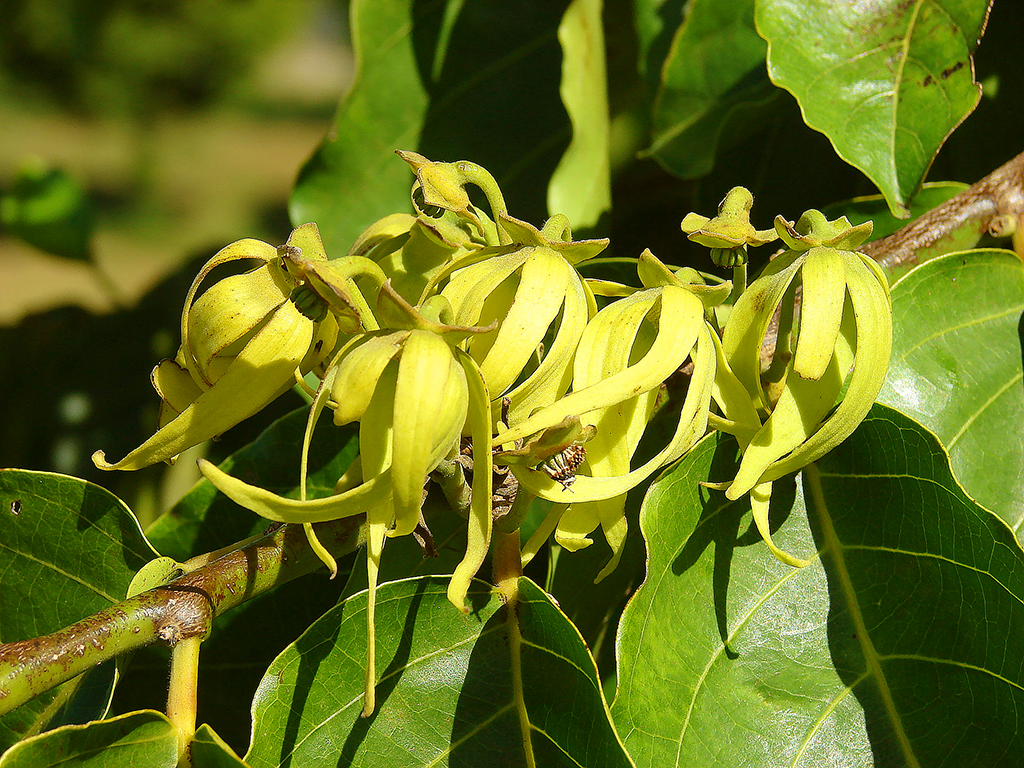
Mayotte
Ylang-Ylang
Cananga odorata

General Description / Cultural Significance
The tall, tropical tree of the Ylang-Ylang, Cananga odorata, is well known throughout the Indian Ocean, especially on the archipelago of Mayotte. The sturdy tree grows commonly as a cash crop on farms throughout the island. It produces brilliant yellow flowers with long, finger-like petals that are so commonly cultivated in Mayotte that they even appear on the country’s official shield. Ylang-Ylang is the country’s lifeblood and vitality, a plant that has become a large-scale export used by the fragrance, medicine, and culinary industries as well as local Mahoran people.
It is safe to say that Ylang-Ylang’s sweet, intoxicating scent has seduced the world: at the beginning of the twenty-first century, Mayotte was made famous for its Ylang-Ylang harvests ranked the finest on the planet. Mayotte is one of the main producers of Ylang-Ylang essential oil, exporting an average of 10-20 tons annually. The fresh, floral fragrance is used in high-end perfumes, often serving as a heart or middle note. Its aroma is enjoyed not only as perfume, but also for its stress-relieving and mood brightening abilities. It is widely considered an aphrodisiac, utilized for its oil during massages and as a remedy for sexual dysfunction. In Mayotte, it is common to smell Ylang-Ylang’s familiar, beloved scent worn on the body as perfume.
While Ylang-Ylang has been extensively exploited in perfumery, the plant has also graced the plates of many cultures around the world. When prepared properly, its sweet scent and taste makes for a flavorful additive to yogurt, ice creams, and baked goods. Also consumed as medicine, Ylang-Ylang has been studied and dispensed for its medicinal abilities. In Mayotte, traditional knowledge keepers known as Fundi carry forward practices of how to use the country’s plants for healing, passed down orally from generation to generation. They understand the island’s biodiversity and the timeless value of medicinal plants, including Ylang-Ylang. Fundi recommended balms, decoctions, poultices, and steams of Ylang-Ylang essential oil to their communities for treating headaches, inflammation of the eye, and gout. The plant’s leaves, applied topically, are still a go-to in relieving itchiness of the skin and are added to the scalp to treat dandruff. The bark has been used to cure stomach aches, fevers, and ulcers. Today, Ylang-Ylang essential oil is collected via steam distillation and prized for its antibacterial, antifungal, amebicidal, and cytotoxic properties.
Although Ylang-Ylang exports have sustained Mayotte’s economy for years, demand for wood consumed during the essential oil distillation process has shrunk the country’s forest. Between 1990 and 2010, Mayotte’s forest cover was reduced by almost a quarter. Ylang-Ylang, Mahoran farmers, and Mayotte’s environment are now caught in a vicious cycle of deforestation, leaving the country’s people, their environment, and the precious Ylang-Ylang vulnerable as climate change brings even more devastation to the region.
Climate Change / Conservation Status
From all directions, Mayotte is deeply impacted as climate change worsens. Along the coasts, delicate mangrove forests are being affected by rising seawater and ocean acidification.
Inland, the volcanic and undulating terrain normally experiences an annual rain and hurricane season that lasts from November to May. That is, until recently. Now, Mayotte is experiencing only extreme drought and untimely, more intense weather events. The year 2017 brought little rain and much of the population was left without drinking water. The country was unprepared for the changing temperatures and weather patterns that have proven to stay. These days, Mayotte experiences at least one drought a year. In addition, the island is at constant risk of cyclones, which rage through the Indian Ocean region, wreaking more havoc than ever in their paths.
Ylang-Ylang farms, which take many years to grow to the point where plants can be cultivated, are being destroyed by harsh rains and rushing waters that tear through plantations. After being demolished by the elements, Mahoran farmers are left to nurture their precious crops back to life as days, months, even years pass without enough rain to sustain them. This unpredictability throws off the timing patterns of pollinators and deprives plants and animals of healthy, sturdy soil and reliable water. Furthermore, it takes a great emotional toll on the people who have grown these plants for generations and are responsible for the years of hard work that it takes to successfully cultivate Ylang-Ylang. If climate change continues to intervene in the relationship between Mayotte and it plants such as Ylang-Ylang, what could be lost is more than a sweet scent. It’s years of traditional knowledge and critical sustenance and income for the people who make it possible for someone across the globe to smell the iconic scent of Ylang-Ylang.
General Description / Cultural Significance
Alternate Names
Motoï (Polynesia)
Sources
Butler, R., 2022. Mayotte Forest Information and Data. Mongabay Environmental News. [website]
Culinaide, 2022. Ylang-Ylang- Flavour. Culinaide. [website]
Helbig, C., 2021. What is Ylang-Ylang? Byrdie. [website]
Lange, S. et al., 2021. Will climate change increase the exposure to droughts? ISIpedia. [website]
Saive, M., 2018. Plants used in traditional medicine and cosmetics in Mayotte Island (France): An ethnobotanical study. Indian Journal of Traditional Knowledge, 17(4), pp.645–653.
Tahitian Secrets, 2018. Ylang-Ylang. Tahitian Secrets. [website]
Tan, L.T. et al., 2015. Traditional uses, phytochemistry, and bioactivities of Cananga odorata (ylang-ylang). Evidence-Based Complementary and Alternative Medicine, 2015, pp.1–30. DOI: 10.1155/2015/896314
V.G. with AFP/RelaxNews, 2015. Production of Ylang Ylang flowers under threat in Comoros? Premium Beauty News. [website]

